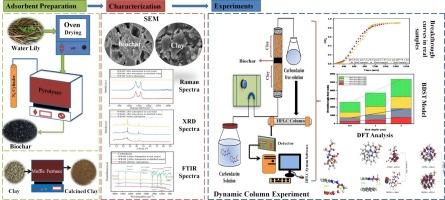通过在煅烧粘土和废物衍生生物炭的连续固定床混合过滤器上的吸附作用去除多菌灵
IF 6.3
2区 工程技术
Q1 ENGINEERING, CHEMICAL
引用次数: 0
摘要
本研究的重点是在连续固定床塔中使用煅烧粘土(CC)和生物炭(WB-BC)双重过滤介质来提高多菌灵(CBZ)的去除率。实验使用了合成水和真实水。在初始 CBZ 浓度为 0.2 mmol L-1、流速为 4 mL min-1、生物炭床层深度为 1 cm、pH 值为 6.8 的连续系统中,观察到传质区(0.64 cm)和吸附容量(0.38mmolg-1)的最佳值。此外,还观察到 WB-BC 和 CC 双滤料能有效吸附真水基质中的 CBZ,平均吸附容量为 0.33mmolg-1。在去除 CBZ 的同时,还观察到实际水样中的氯化物、硫酸盐、硝酸盐、Ca2+ 和 Mg2+ 的浓度显著降低。利用质量转移模型进行的分析表明,BDST 模型有效地描述了突破曲线数据。密度泛函理论(DFT)计算显示,与 CC 相比,WB-BC 与 CBZ 的相互作用更强,吸附能力更高,这体现在 WB-BC-CBZ 复合物的垂直距离(2.711 Å)更短,吸附能值(-42.95kJmol-1)更高。此外,WB-BC-CBZ 复合物的带隙 (ΔE)值(2.881 eV)更大,表明其结构稳定性和化学硬度更高。本文章由计算机程序翻译,如有差异,请以英文原文为准。

Removal of carbendazim by sorption onto a continuous fixed bed hybrid filter of calcined clay and waste derived biochar
This study focused on enhanced Carbendazim (CBZ) removal by using dual filter media of calcined clay (CC) and biochar (WB-BC) in a continuous fixed-bed column. The experiments were carried out using synthetic and real water. In the continuous system with an initial CBZ concentration of 0.2 mmol L−1, a flow rate of 4 mL min−1, a bed depth of biochar 1 cm and a pH of 6.8, the optimal values for the mass transfer zone (0.64 cm) and adsorption capacity (0.38mmolg−1) were observed. Furthermore it was observed that the dual filter media of WB-BC and CC effectively adsorbs CBZ from real water matrix, with an average adsorption capacity of 0.33mmolg−1. Significant reduction in the concentrations of chlorides, sulfates, nitrates, Ca2+, and Mg2+ were also observed in real water samples along with CBZ removal. Analysis using mass-transfer models showed that BDST model effectively described the breakthrough curve data. Density Functional Theory (DFT) calculations revealed that WB-BC exhibits a stronger interaction and higher adsorption capacity for CBZ compared to CC as evidenced by a shorter vertical distance (2.711 Å) and higher adsorption energy value (−42.95kJmol−1) in case of WB-BC-CBZ complex. Additionally, the larger band gap (ΔE) value (2.881 eV) for WB-BC-CBZ complex indicates superior structural stability and chemical hardness.
求助全文
通过发布文献求助,成功后即可免费获取论文全文。
去求助
来源期刊

Journal of water process engineering
Biochemistry, Genetics and Molecular Biology-Biotechnology
CiteScore
10.70
自引率
8.60%
发文量
846
审稿时长
24 days
期刊介绍:
The Journal of Water Process Engineering aims to publish refereed, high-quality research papers with significant novelty and impact in all areas of the engineering of water and wastewater processing . Papers on advanced and novel treatment processes and technologies are particularly welcome. The Journal considers papers in areas such as nanotechnology and biotechnology applications in water, novel oxidation and separation processes, membrane processes (except those for desalination) , catalytic processes for the removal of water contaminants, sustainable processes, water reuse and recycling, water use and wastewater minimization, integrated/hybrid technology, process modeling of water treatment and novel treatment processes. Submissions on the subject of adsorbents, including standard measurements of adsorption kinetics and equilibrium will only be considered if there is a genuine case for novelty and contribution, for example highly novel, sustainable adsorbents and their use: papers on activated carbon-type materials derived from natural matter, or surfactant-modified clays and related minerals, would not fulfil this criterion. The Journal particularly welcomes contributions involving environmentally, economically and socially sustainable technology for water treatment, including those which are energy-efficient, with minimal or no chemical consumption, and capable of water recycling and reuse that minimizes the direct disposal of wastewater to the aquatic environment. Papers that describe novel ideas for solving issues related to water quality and availability are also welcome, as are those that show the transfer of techniques from other disciplines. The Journal will consider papers dealing with processes for various water matrices including drinking water (except desalination), domestic, urban and industrial wastewaters, in addition to their residues. It is expected that the journal will be of particular relevance to chemical and process engineers working in the field. The Journal welcomes Full Text papers, Short Communications, State-of-the-Art Reviews and Letters to Editors and Case Studies
 求助内容:
求助内容: 应助结果提醒方式:
应助结果提醒方式:


